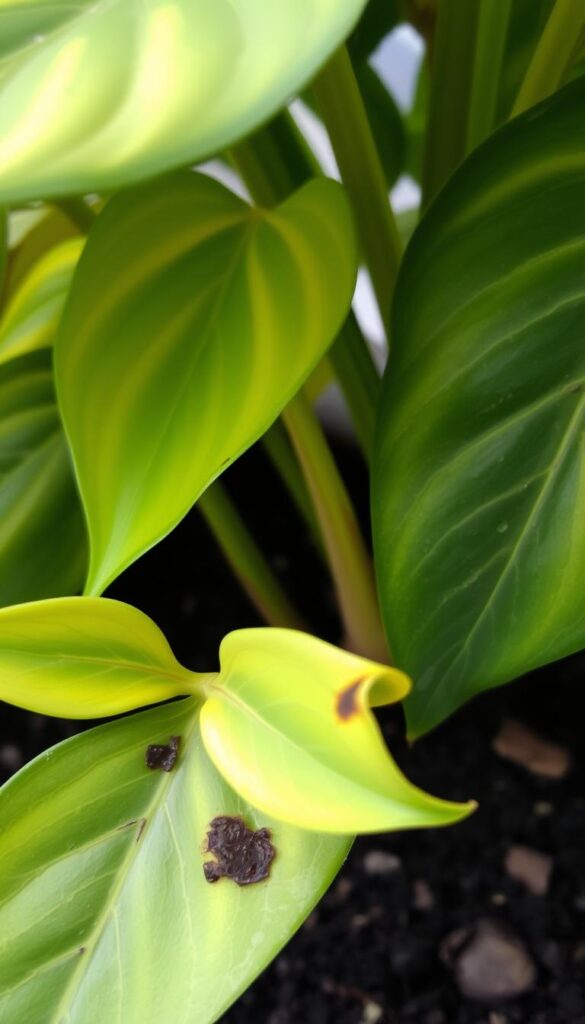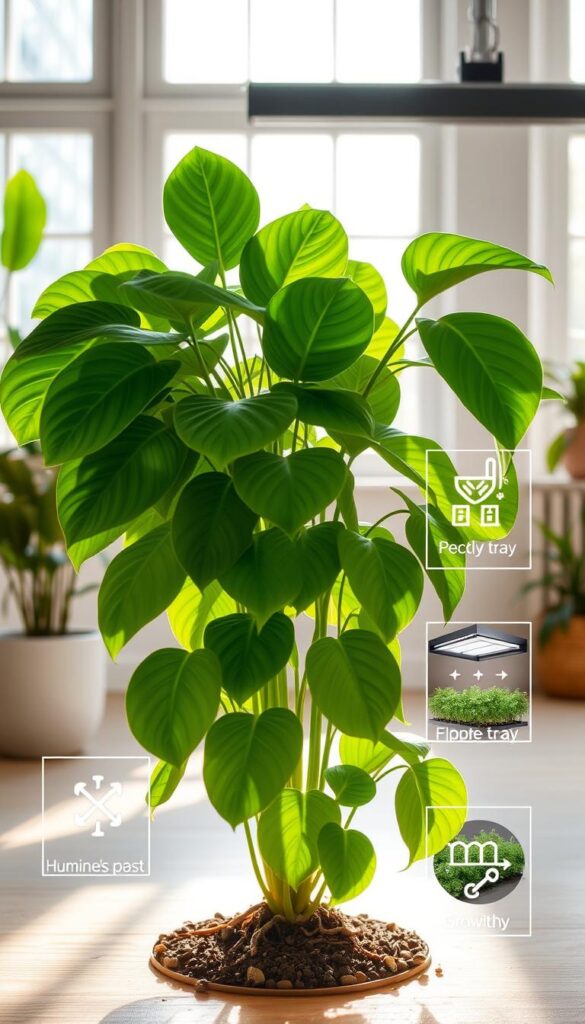I still remember the first time I brought a philodendron into my home. It was a small, vibrant plant with heart-shaped leaves, and I was excited to watch it grow. But as the days went by, I noticed its leaves turning yellow, and I couldn’t figure out why. That’s when I realized the importance of understanding how often to water philodendron plants.
As I learned, philodendrons thrive in conditions that mimic their tropical origins. This means generous watering during spring and summer, with a significant reduction in water during the colder months. But finding the right balance isn’t always easy. Too much water can lead to root rot, while too little can cause the leaves to wilt and lose their vibrancy.
Over time, I developed a simple routine. I check the soil moisture by gently poking my finger into the soil up to the first knuckle. If the soil feels dry, it’s time to water. If it’s still damp, I wait another day or two. This method has helped me keep my philodendron healthy and thriving.
Proper watering is just one part of philodendron care, but it’s a critical foundation for healthy growth. By paying attention to the soil and adjusting your routine with the seasons, you can create an environment where your philodendron flourishes. In this article, I’ll share expert tips and techniques to help you master the art of watering your philodendron.
Understanding Your Philodendron’s Watering Needs
Understanding your philodendron’s watering needs starts with the soil it grows in. The right soil and drainage system are crucial for maintaining the health of your plant. Without proper drainage, water can accumulate in the soil, leading to root rot and other issues.
The Role of Soil and Drainage
The type of soil you use plays a significant role in your philodendron’s health. A well-draining potting mix is essential to prevent waterlogged soil. Adding perlite to your soil mix can improve aeration and drainage, ensuring healthier roots. It’s also important to maintain a moist yet non-saturated potting soil, as this balance is crucial for the plant’s survival.
Regularly checking the drainage holes in your pot is another key aspect of philodendron care. Ensuring these holes are clear prevents water from pooling at the bottom of the pot, which can lead to root rot. By selecting a proper mix that allows for optimal drainage and moisture retention, you can create a healthy environment for your plant to thrive.
High Humidity and Its Effects
High humidity, naturally found in tropical environments, significantly influences your philodendron’s watering needs. In more humid climates, the soil may retain moisture longer, potentially reducing the frequency of watering needed. Conversely, in drier environments, you may need to water more frequently to compensate for the lack of ambient moisture.
Maintaining the right moisture levels in the soil is vital. The soil should retain enough moisture to keep the plant hydrated but shouldn’t be soggy. This balance ensures that the roots receive the right amount of water without becoming waterlogged. By understanding how moisture retention works in your specific environment, you can adjust your watering routine accordingly.
How Often to Water Philodendron: Identifying the Right Schedule
Consistency is key when it comes to watering your philodendron. Over time, I’ve found that checking the soil moisture is the best way to determine if it’s time to water. This simple practice has become a cornerstone of my plant care routine.
Using the Finger Test for Soil Moisture
I use the finger test to check if the top inch of soil is dry. By inserting my finger up to the first knuckle, I can feel if the soil is dry or still damp. This method helps me decide whether it’s time to water or wait another day. It’s a quick and effective way to ensure I’m not overwatering or underwatering my plant.
Seasonal Adjustments and My Observations
During the warmer months, I water my philodendron about once a week. In the winter, I reduce this to every 10 days. I’ve noticed that the top inch of soil dries out faster in summer, so I check it more frequently. By adjusting my watering schedule with the seasons, I ensure my plant gets exactly what it needs for healthy growth.
Preventing Overwatering and Underwatering
One of the most critical aspects of philodendron care is recognizing when your plant is getting too much or too little water. Over the years, I’ve learned to identify the subtle signs that indicate my plant’s watering needs.
Recognizing Signs of Overwatering
Yellowing leaves and drooping stems are clear indicators of overwatering. If the soil remains soggy and the saucer is filled with excess water, it’s a sign that your plant is at risk of root rot. Mushy stems and a soft texture are also warning signs that you’re watering too frequently. It’s important to act quickly by adjusting your watering schedule to prevent further damage.

Root rot is a common issue caused by excess water. If you notice your plant’s leaves turning yellow or the stem becoming mushy, it’s crucial to inspect the roots. Gently remove the plant from its pot and trim any rotting roots with sterile tools. This will help prevent the spread of rot and give your plant a chance to recover.
Spotting Underwatering Warnings
On the other hand, underwatering can cause leaves to turn brown and crispy, especially around the edges. Droopy leaves that don’t perk up even after watering are another sign that your plant needs more hydration. It’s essential to find a balance to keep your philodendron healthy and thriving.
Always make sure to empty any excess water from the saucer to avoid creating a stagnant environment. A healthy stem and vibrant leaves are good indicators that your plant is receiving the right amount of water. By paying attention to these visual cues, you can adjust your watering routine to meet your philodendron’s needs.
Expert Techniques for Effective Watering
When it comes to watering your philodendron, the method you choose can make a big difference. I’ve found that understanding the best techniques can help you avoid common mistakes and keep your plant thriving.
Watering Methods: Top vs. Bottom Techniques
Watering from the top is a traditional method that helps settle the soil, especially after repotting. However, I’ve discovered that watering from the bottom encourages a deeper root system, which can make your plant more robust. To try this, place your pot in a tray filled with water and let it absorb from the bottom. This approach reduces soil compaction and allows the potting mix to draw in water evenly.
Practical Tips for Room-Temperature Watering
Using room-temperature water is a simple yet effective tip. Avoid using cold water, as it can shock the roots. To check if the water is at a safe temperature, let it sit for about 30 minutes before watering. This ensures it’s not too cold or too warm for your plant. Additionally, using a potting mix designed for good drainage will help the water spread evenly through the soil, preventing any waterlogged areas.
By combining these techniques—choosing the right potting mix, using room-temperature water, and selecting either top or bottom watering—you can create a watering routine that works best for your philodendron. Experiment with these methods to find what keeps your plant happy and healthy.
Optimizing Your Philodendron’s Growth Environment
Creating the right environment for your philodendron is key to its success. By focusing on the pot, soil, light, and temperature, you can mimic the tropical conditions these plants love.
Selecting the Ideal Soil and Potting Mix
A well-draining pot is essential to prevent waterlogged soil. I recommend using a potting mix with perlite or sand to improve drainage. This helps maintain healthy roots and keeps the soil moist without making it soggy.
Managing Light, Temperature, and Humidity
Place your philodendron in a bright area with indirect light. Direct sunlight can scorch the leaves. Keep the temperature between 65-75°F, avoiding cold drafts. Humidity levels should be moderate, around 40-60%. You can increase humidity by placing the pot on a tray filled with water and pebbles.
| Factor | Ideal Condition | Tips |
|---|---|---|
| Light | Bright, indirect | Avoid direct sunlight |
| Temperature | 65-75°F | Keep away from drafts |
| Humidity | 40-60% | Use a water tray |
| Soil | Well-draining | Add perlite or sand |

By adjusting these factors, you can create a thriving environment for your philodendron. Small changes can make a big difference in its health and growth.
Parting Insights for Thriving Philodendrons
As I reflect on my journey with philodendrons, I’ve learned that thriving plants are the result of attentive care and a few simple yet crucial practices. One of the most important lessons is ensuring that every drainage hole in the pot is clear, allowing excess water to escape and preventing root rot.
Choosing the right place for your philodendron is equally vital. It should receive bright, indirect light and be in an area with moderate humidity. Sometimes, it’s best to leave your plant to adjust naturally, trusting your observations to guide its care. Each philodendron has unique needs, so tuning in to these specifics is key to its success.
Finding the right way to balance watering with environmental factors like high humidity is essential for long-term health. Remember, it’s all about harmony—ensuring the roots have space to breathe and the soil isn’t waterlogged. By following these insights, you’ll be well on your way to growing a vibrant, thriving philodendron. Enjoy the journey of nurturing your plant and watching it flourish!
